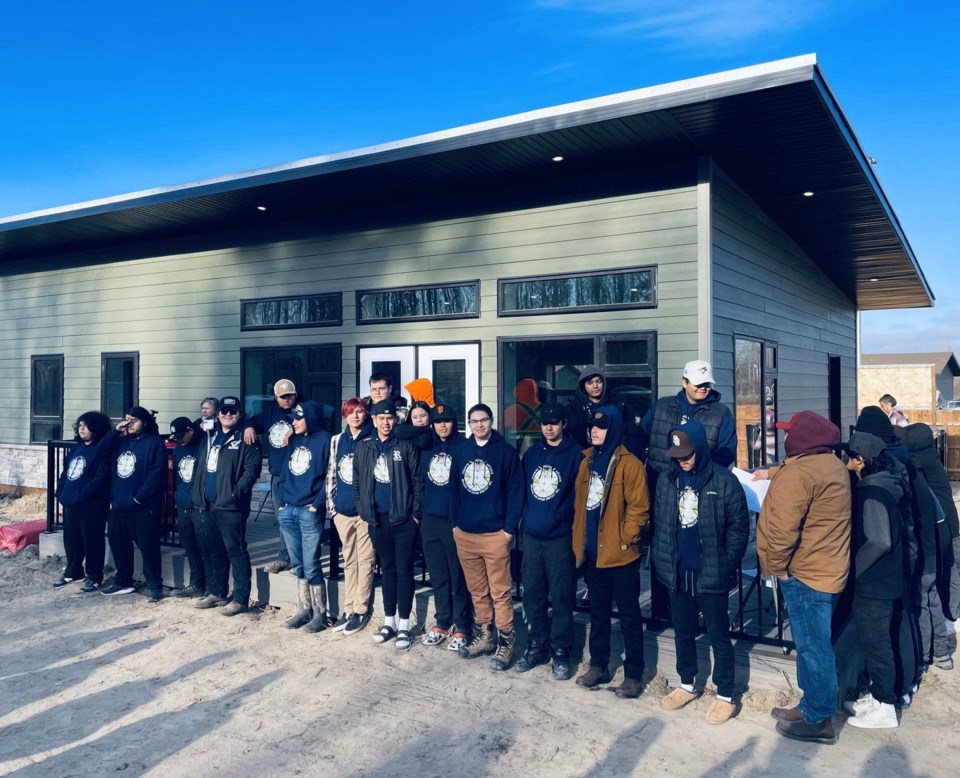CANOE LAKE — It started, with just a hole in the ground and a pile of lumber.
Now, thanks to the work of a handful of high school students, Canoe Lake Cree First Nation (CLCFN) has a newly built safe house for kids and families in need of refuge.
“It brings me joy to know I worked on something that people are going to use,” said Sydney Lariviere, grade 12 student at Canoe Lake Miksiw School. “It’s not going to be thrown out, it will be taken care of.”
The housing project is something the youth can be proud of for years to come.
“I’ll come back in 20 years and tell my kids, ‘I helped build this, to help kids in need,’ ” she said.
This three-year building program, Kanaweyiminan "take care of us" CFS Safe House, blended high school programming with an on-site, hands-on education in-house building.
The small group of high school students, along with instructors and local tradespeople, completed the 1,600 square foot, four-bedroom, bungalow-style house this fall.
“It provides them with a snapshot of those pathways to a career in the trades,” said Sheldon Couillonneur the trades consultant and educator who worked with the youth on the build.
“I think this project will help them find passion, will help them discover purpose.”
The project, conceived in 2019, was created by CLCFN leadership and members of the Oskāyak Pasikonatanik non-profit corporation, as a way to provide youth with a project-based learning experience for the high school trades program.
“It’s important that we give our youth an opportunity to feel connected to our community,” said Wilfred Iron, CLCFN councillor. “And being able to acquire the skills and abilities to pursue a career in the trades.”
The students dove into the world of carpentry, electrical, and plumbing during the almost three-year home build, which they broke into steps, so they understood the complete process from start to finish.
Students were first divided into cohorts where they studied the building plans, completed their safety training, and learned about each module in the classroom.
Then, they were welcomed by the consultants and tradespeople to help complete the builds, which included putting up beams, excavation, laying down flooring, installing windows and more.
“This isn’t just a trades program, this is a lifestyle,” said Couillonneur. “Everyone here will own a home and will keep maintenance on their home. This changes the whole principle and fundamental belief in building something and taking pride in what you own.”
Ultimately, the goal of the program is to create first-generation carpenters and tradespeople he said.
Currently, seven of the students who participated in the program have graduated and are looking at moving forward to level one carpentry at the Saskatchewan Indian Institute of Technologies.
One of those students considering taking their learned skills to post-secondary is Ashton Lariviere, who worked on the house for the last two-and-a-half years.
“I always looked forward to (working on the safe house),” he said. “I enjoyed being there a lot more than being in the classroom. It’s rewarding knowing I built something. I could see myself continuing to do something like this.”
Nov. 1, CNLCN celebrated the opening of the safe house where the students, who worked on the building project, presented a key to the band council.
The safe house fills a need at CNLCN to improve on-reserve housing conditions, as the house will provide shelter and refuge to families or children who might not have sustainable housing or are dealing with conflict or issues at home.
“To watch the youth that have been here since day one hand over the keys was a powerful moment,” said Couillonneur.
“They were the ones doing all the drilling, all the calking, all the heavy lifting. They’ve invested all this time and energy into it. And now they have hours of experience and insight into both the lifestyle of a tradesperson and the teamwork that exists on a site like that.”
The rewards go past the experience and knowledge gained for students like Tayven Yew.
For him, it was about knowing he did his part to make a difference in someone’s life.
“It feels more rewarding because there’s going to be people living here,” said Yew. “The winter season is coming up, and we built it for all seasons. So, it’s rewarding knowing that we did something to help people here.”
— Submitted by Sask Polytech Media Relations




